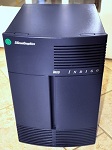I've been wondering for a week or so now why Silicon Graphics chose the pizza box approach for the Indigo 2 and Indy? The Indy I get since it was a low cost machine going against other machines at the time (Sun's SPARCstation, NeXT's NeXTstation, PCs etc.). But the departure from the extremely stylized and iconic Indigo for it's successor I find extremely odd. Were people at the time wanting a more practical machine they could rest a 19" CRT on their workstation? Were the stands for the Indigo 2 meant to appeal to those who didn't want to do that? And then a few years later the O2 and Octane returned to the stylized approach.
 33mhz R3k/48mb/XS24
33mhz R3k/48mb/XS24
 150mhz R4400/256mb/XL24
150mhz R4400/256mb/XL24
 600mhz R14kA/2gb/V10
600mhz R14kA/2gb/V10
 8x1.4ghz Itanium 2/8GB
8x1.4ghz Itanium 2/8GB
 32x600mhz R14kA/24GB
32x600mhz R14kA/24GB
 4x700mhz R16k/8GB/V12/DCD/SAS/FC/DM5 (2x)
4x700mhz R16k/8GB/V12/DCD/SAS/FC/DM5 (2x)
 4x700mhz R16k/4GB
4x700mhz R16k/4GB
 2x1.6ghz 8mb/12gb/SAS/2xFGL
2x1.6ghz 8mb/12gb/SAS/2xFGL










 Octane - (Montrealais) - R12K - 2*360MHZ - 1024MB RAM - EMXI. - 6.5.30
Octane - (Montrealais) - R12K - 2*360MHZ - 1024MB RAM - EMXI. - 6.5.30










 -
-










 might have had more to do with the very stable image, drastically lower energy requirements and heat output and the lack of the high pitched whine that CRTs emit. also, how did we ever fit keyboards, wacom tablets and CRTs on a normal sized office desk?
might have had more to do with the very stable image, drastically lower energy requirements and heat output and the lack of the high pitched whine that CRTs emit. also, how did we ever fit keyboards, wacom tablets and CRTs on a normal sized office desk?



 (single-CM)
(single-CM)